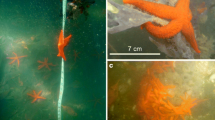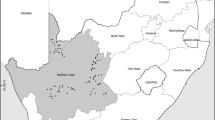Abstract
One characteristic pattern found in the marine Antarctic shallow environments is the unusually high proportion of species with protected and pelagic lecitotrophic development modes. However, species with planktotrophic development generally appear as the most conspicuous types of organisms in these environments. The Antarctic shallow benthos is considered as one of the most disturbed in the world, mainly due to the action of ice, thus one could hypothesize that such an environment should favor organisms with high dispersal capability. In order to test this general hypothesis, for two consecutive summers (2004–2005) and at two locations, we quantified the abundance and size distribution of most echinoderms present along bathymetric transects. Our results show the predominance of broadcasters (i.e., Sterechinus neumayeri and Odontaster validus) at a location where disturbances are common, while brooders (e.g., Abatus agassizii) only occurred at shallower depths of the least disturbed location. These results not only corroborate the hypothesis that local disturbance is an important factor generating these ecological patterns, but also suggest how ice-related disturbances could represent a major selecting agent behind the patterns of species diversity at an evolutionary scale in Antarctica.




Similar content being viewed by others
References
Arnaud PM (1974) Contribution à la bionomie marine benthique des regions antarctiques et subantarctiques. Téthys 6:467–653
Arntz WE, Brey T, Gallardo VA (1994) Antarctic zoobenthos. Oceanogr Mar Biol Anu Rev 32:241–304
Barnes DKA, Brockington S (2003) Zoobenthic biodiversity, biomass and abundance at Adelaide Island, Antarctica. Mar Ecol Prog Ser 249:145–155
Barnes DKA, Linse K, Waller C, Morely S, Enderlein P, Fraser KPP, Brown M (2006) Shallow benthic fauna communities of South Georgia Island. Polar Biol 29:223–228
Bowden DA (2005) Quantitative characterization of shallow marine benthic assemblages at Ryder Bay, Adelaide Island, Antarctica. Mar Biol 146:1235–1249
Brey T, Gutt J (1991) The genus Sterechinus (Echinodermata: Echinoidea) on the Weddell sea shelf and slope Antarctica, distribution, abundance and biomass. Polar Biol 11:227–232
Brey T, Pearse J, Basch L, McClintock J, Slattery M (1995) Growth and production of Sterechinus neumayeri (Echinoidea: Echinodermata) in McMurdo Sound, Antarctica. Mar Biol 124:279–292
Brown KM, Fraser KP, Barnes DK, Peck LS (2004) Links between the structure of an Antarctic shallow-water community and ice-scour frequency. Oecologia 141:121–129
Clarke A (1992) Reproduction in the cold: Thorson revisited. Invertebr Reprod Dev 22:175–184
Dayton PK (1971) Competition, disturbance and community organization: the provision and subsequent utilization of space in a rocky intertidal community. Ecol Monogr 41:351–389
Dayton PK (1990) Polar benthos. In: Smith WO (ed) Polar oceanography. Academic, London, pp 631–685
Dayton PK, Robilliard GA, Paine RT (1970) Benthic faunal zonation as a result of anchor ice formation at McMurdo Sound, Antarctica. In: Holdgate MW (ed) Antarctic ecology, Academic, London pp 244–257
Dayton PK, Robilliard GA, Paine RT, Dayton LB (1974) Biological accommodation in the benthic community at McMurdo Sound, Antarctica. Ecol Monogr 44:105–128
Echeverría CA, Paiva PC, Alves VC (2005) Composition and biomass of shallow benthic megafauna during an annual cycle in Admiralty Bay, King George Island, Antarctica. Antarct Sci 17:312–318
Gutt J (2001) On the direct impact of ice on marine benthic communities, a review. Polar Biol 24:553–564
Imbrie J, Berger A, Boyle EA, Clemens SC, Duffy A, Howard WR, Kukla G, Kutzbach J, Martinson DG, McIntyre A, Mix AC, Molfino B, Morley JJ, Peterson LC, Pisias NG, Prell WL, Raymo ME, Shackleton NJ, Toggweiler JR (1993) On the structure and origin of major glaciation cycles. 2. The 100,000 year cycle. Paleoceanography 8:699–735
Jackson JBC, Cheetham AH (1999) Tempo and mode of speciation in the sea. Trends Ecol Evol 14:72–77
Jadwiszczak P (2003) Rundom Projects 2.0 LITE. Statistical software available from the web site http://www.pjadw.tripod.com
Manjón-Cabeza ME, Ramos A (2001) Distribution of asteroid genera (Echinodermata) off South Shetland Islands and the Antarctic Peninsula. Bol Inst Esp Oceanogr 17:263–270
Manjón-Cabeza ME, Ramos A (2003) Ophiuroid community structure of the South Shetland Islands and Antarctic Peninsula region. Polar Biol 26:691–699
McClintock JB, Pearse JS, Bosch I (1988) Population structure and energetics of the shallow-water Antarctic sea star Odontaster validus in contrasting habitats. Mar Biol 99:235–246
Mespoulhé P, David B (1992) Stratégie de croissance d’un oursin subantarctique: Abatus cordatus des Iles Kerguelen. CR Acad Sci Paris 314:205–211
Nonato EF, Brito TAS, De Paiva PC, Petti MAS, Corbisier TN (2000) Benthic megafauna of the nearshore zone of Martel Inlet (King George Island, South Shetland Islands, Antarctica): depth zonation and underwater observations. Polar Biol 23:580–588
Pearse JS (1994) Cold-water echinoderms break ‘Thorson’s Rule’. In: Young CM, Eckelberger KJ (eds) Reproduction, larval biology and recruitment of the deep-sea. Columbia University Press, New York, pp 26–43
Pearse JS, Lockhart SJ (2004) Reproduction in cold water: paradigm changes in the 20th century and a role for cidaroid sea urchins. Deep-Sea Res II 51:1533–1549
Pearse JS, McClintock JB (1990) A comparison of reproduction by the broodingspatang oid echinoids Abatus shackletoni and A. nimrodi in McMurdo Sound, Antarctica. Invert Reprod Dev 17:181–191
Pearse JS, McClintock JB, Bosch I (1991) Reproduction of Antarctic benthic marine invertebrates: tempos, modes, and timing. Amer Zool 31:65–80
Poulin E, Féral JP (1994) The fiction and the facts of Antarctic brood protecting: population genetics and evolution of schizasterid echinoids. In: David, Guille, Féral, Roux (eds) Echinoderms through time, Balkema, Rotterdam, pp 837–843
Poulin E, Féral JP (1995) Pattern of spatial distribution of a brood-protecting Schizasterid Echinoid, Abatus cordatus, endemic to Kerguelen Islands, Mar Ecol Prog Ser 118:179–186
Poulin E, Palma AT, Féral J-P (2002) Evolutionary versus ecological success in Antarctic benthic invertebrates. Trends Ecol Evol 17:218–222
Pugh PJA, Davenport J (1997) Colonisation vs. Disturbance: the effects of sustained ice-scouring on intertidal communities. J Exp Mar Biol Ecol 210:1–21
Raguá-Gil JM, Gutt J, Clarke A, Arntz WE (2004) Antarctic shallow-water mega-epibenthos: shaped by circumpolar dispersion or local conditions? Mar Biol 144:829–839
Sahade R, Tatián M, Kowalke J, Kühne S, Esnal GB (1998) Benthic faunal associations on soft substrates at Potter Cove, King George Island, Antarctica. Polar Biol 19:85–91
Sokal RR, Rohlf FJ (1995) Biometry, 3rd edn. Freeman, San Francisco, pp 887
Thatje S, Hillenbrand C-D, Larter R (2005) On the origin of Antarctic marine benthic community structure. Trends Ecol Evol 20:534–540
Thompson BAW, Riddle MJ (2005) Bioturbation behaviour of the spatangoid urchin Abatus ingens in Antarctic marine sediments. Mar Ecol Prog Ser 290:135–143
Wahle RA, Steneck RS (1991) Recruitment hábitats and nursery grounds of the American lobster Homarus americanus: a demographic bottleneck? Mar Ecol Prog Ser 69:231–243
Acknowledgments
This work was possible because of the help and support provided by Verónica Vallejos, David Domenec and Manuel Gidekel, as well as by the key logistic support of the Peruvian Air Force during the first campaign and by the Chilean Army, particularly the personnel of the O’Higgins base during the second campaign. This research was supported by grant INACH 02-02 to ATP and EP and PIA to EP.
Author information
Authors and Affiliations
Corresponding author
Rights and permissions
About this article
Cite this article
Palma, A.T., Poulin, E., Silva, M.G. et al. Antarctic shallow subtidal echinoderms: is the ecological success of broadcasters related to ice disturbance?. Polar Biol 30, 343–350 (2007). https://doi.org/10.1007/s00300-006-0190-x
Received:
Revised:
Accepted:
Published:
Issue Date:
DOI: https://doi.org/10.1007/s00300-006-0190-x




